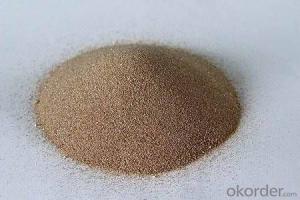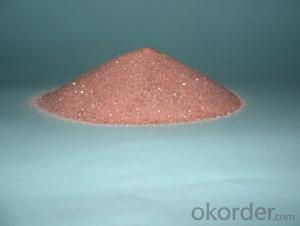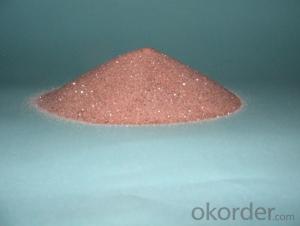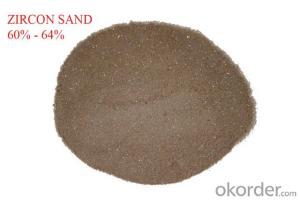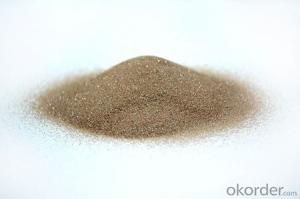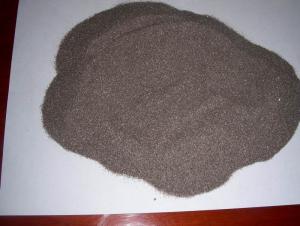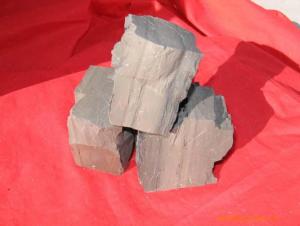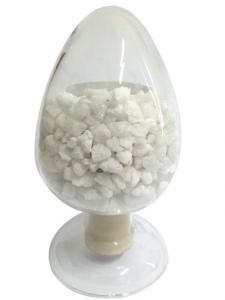Zircon Sand and Zircon Powder High Performafce for Refractory Use 66-67%
- Loading Port:
- Tianjin
- Payment Terms:
- TT OR LC
- Min Order Qty:
- 25 m.t.
- Supply Capability:
- 3000 m.t./month
OKorder Service Pledge
OKorder Financial Service
You Might Also Like
Zircon Sand and Zircon Powder High Performafce for Refractory Use
1.Structure of Zircon Sand and Zircon Powder
This product is produced with the advantage of good high temperature stability of zircon sand.It has the characteristics of high strength ,high density and high refractoriness under load .So,this product has good performance of spalling resistance,abrasion resistance, liquid glass erosion resistance and other industrial slag erosion resistance.
2.Main Features of Zircon Sand and Zircon Powder
1 Tiny, round, solid ball shape provides greater surface area for improved performance and dispersion in its application
2 High refractory rating, lower specific gravity rating, and higher service temperature produces greater yield
3 With lower bulk density, it offers better air permeability for better performance as a result of its overall physical characteristics
3.Main usage of Zircon Sand and Zircon Powder
1. The 80-120M zircon sand is used in investment casting, the processing is called dipping.
2. It can enhance the shell`s thickness.
3. It is specialize used in inner layer being mixed with silica sol.
4. Zircon Sand and Zircon Powder Images

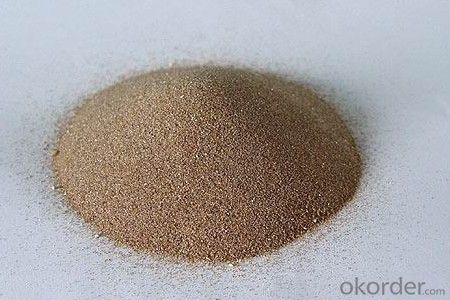
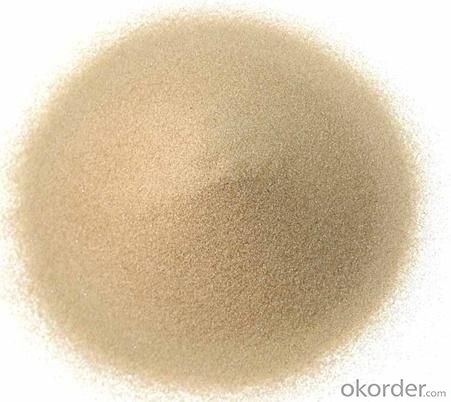
5. Zircon Sand and Zircon Powder Specification
Item | SY8 | SY6 |
Zr Content (ZrO2) | ≥66% | ≥65.5% |
Fe Content (Fe2O3) | ≤0.08% | ≤0.12% |
Ti Content (TiO2) | ≤0.10% | ≤0.10% |
6.FAQ of Zircon Sand and Zircon Powder
1). Q: Are you a factory or trading company?
A: We are a factory.
2). Q: Where is your factory located? How can I visit there?
A: Our factory is located in China. You are warmly welcomed to visit us!
3). Q: How can I get some samples?
A: Please contact me for samples
- Q:How to distinguish the fire resistant level of the rubber and plastic thermal insulation material?
- Level A of non-combustible insulation materials are: W W inorganic active wall insulation materials, cement foam insulation board, glass beads of insulation mortar, rock wool board, glass wool board and foam ceramics, ect. Th e level A is non-combustible material, characterized with low density, low thermal conductivity, high bearing capacity, convenient construction, economy and durablity, and widely used as the thermal insulation materials in hot pipes, thermal equipment and other pipe-line equipment and industrial architectures, and as the thermal insulation, heat insulation and sound-absorbing materials in industrial and civil building envelope. Because of its good thermal stability, it is more used as fire-resistant protective coating material of steel structure.
- Q:What are included in roof thermal insulation fireproofing material?
- Aluminium foil, bubble, aluminium foil/air bubbles/fireproofing aluminium foil thermal insulation material, fireproofing bubble thermal insulation material, fire?retardant thermal insulation material, thermal insulation construction materials, aluminum foil insulation material.
- Q:What are the physical properties of refractory material?
- The mechanical properties of refractory material include compressive strength, volume density and sclerosing, slag resistance, elastic modulus, thermal shock resistance, oxidation resistance, bibulous rate, fluidity, resilience, bond strength and slump, electrical conductivity, specific heat, heat capacity, the impact strength, linear change, torsional strength, stomatal aperture distribution, resistance to acid, etc. The use performance of refractory material include refractoriness, thermal emissivity, condensation, porosity, coefficient of thermal expansion. Thermal properties of refractory material include thermal conductivity, temperature conductivity, plasticity, the hydration resistance, creep performance. The physical properties of the refractory materials include structure performance, mechanical properties, shear strength, load softening temperature, CO erosion resistance. The structure properties of the refractory materials include porosity, alkali resistance and sintering. The operating performance of refractory material include consistency, tensile strength, the use performance and operating performance, wear resistance, bending strength, thermal properties.
- Q:What does refractory mean?
- Ordinary refractories are often used brick, semisilica brick, clay brick, high alumina brick, magnesia brick etc..Special materials often use AZS brick, corundum brick, magnesia chrome brick, silicon carbide, silicon nitride bonded silicon carbide, nitrides, silicides, sulfide, boride, carbide and other non oxide refractory materials; calcium oxide, chromium oxide, alumina, Magnesium Oxide, beryllium and other refractory materials. Often used insulation refractories are diatomite products, asbestos products, insulation panels and so onUnshaped refractory materials commonly used are fettling, refractory ramming material, refractory castable, refractory plastic material, refractory clay, refractory gunning, refractory cast material, fireproof coating, lightweight castable, mud etc..
- Q:On the problem of making refractory materials
- Refractories mainly depend on their high melting point characteristics. The refractory market is mainly Magnesium Oxide material.
- Q:What's the refractory material in common use currently?
- (1) Alumina-silica refractory brick: Except the transition band, hot end and firing zone of the rotatory cement kiln, it can be applied to the whole burning system of the precalcining kiln, such as the fixed wall lining, wicket, cooling machine, tertiary air duct, burner, etc. It mainly includes alkali-resisting brick, high alumina (anti stripping) brick, silica-mullite brick, etc. (2) Basic refractory: For the upper transition band close to the part of burning zone and the burning zone, its inner lining can endure the highest flame temperature of 2000℃ and material temperature of 1350℃-1400℃, and it also has to withstand the permeation of sulfur and alkali compounds, permeation, thermal shock and oxidoreduction of hot-melt clinkers (liquid phase), mechanical stress of elliptic cylinder deformation, etc. Therefore, inner linings are the most demanding parts to withstand stress, and only basic refractory can meet with requirements under this working condition. (3) Fireclay insulating refractory: Its microstructure has notable characteristics of high porosity, large pore size and thermal insulation performance. For its low volume density and light weight, it is usually referred to as lightweight refractory. Fireclay insulating refractory product has great varieties, and it is usually classified and named according to its chemical and mineral compositions or production raw materials, and it is also classified according to its operating temperature and material form. Currently, the most used main thermal insulation material for the precalciner kiln system at home and abroad is calcium silicate board; besides, light weight castable and insulating fire brick are increasingly used year by year. Other thermal insulation materials are mainly ceramic fiber products.
- Q:Can anyone say something about the curtain wall fire-proof material key sealing point?
- When sealing the gaps between glass?curtain?wall and floors of all layers and the outer edge of the partition with rock wool or mineral wool, its thickness should not be less than 100mm and should be filled densely; Rock wool or mineral wool for horizontal smoke prevention zone between floors should use galvanized steel sheet whose thickness is not less than 1.5mm to support; The gaps between supporting plate, major structure, curtain wall structure and supporting plate should be filled with fire-resistant glass, whose fire endurance should meet the design requirements. Fire-resistant glass for curtain wall are mainly include monolithic fire-resistant glass as well as the hollow glass and laminated glass made by monolithic fire-resistant glass.
- Q:Which are fireproofing external wall materials?
- According to combustion performance, external wall thermal insulation materials are classified as Grade-A and Grade-B. Grade-A refers to incombustible material and Grade-B combustible material. A few years ago the fire in CCTV building and Shenyang Hotel were caused by Grade-B material. Currently Grade-A material is more commonly uesd and less expensive than Grade-B material. Grade-A material can be divided into thermal mortar, phenolic foam board, rock wool board, foam cement board, etc. Thermal mortar is easy for construction and unexpensive, but it is also easy for faking due tou its simple procesing. It is recommended to find a large factory whihc has gone through the formalities.
- Q:What is the use of refractory?
- It is fire-retardant and insulated.
- Q:I wanna ask that magnesium oxide is refractory?
- Magnesium oxide. magnesium oxide has high refractory insulation properties. After above 1000 ℃ high temperature burning, it can be transformed into crystals. And it can be transformed into dead-burned magnesium oxide or sintered magnesia oxide until rising to above 1500 ℃. It has heat-resistant, non-conductive at room temperature and relatively poor thermal conductivity. Magnesium oxide is mainly used for the preparation of ceramic, enamel, refractory crucible and refractory bricks. I hope to help you
1. Manufacturer Overview |
|
|---|---|
| Location | |
| Year Established | |
| Annual Output Value | |
| Main Markets | |
| Company Certifications | |
2. Manufacturer Certificates |
|
|---|---|
| a) Certification Name | |
| Range | |
| Reference | |
| Validity Period | |
3. Manufacturer Capability |
|
|---|---|
| a)Trade Capacity | |
| Nearest Port | |
| Export Percentage | |
| No.of Employees in Trade Department | |
| Language Spoken: | |
| b)Factory Information | |
| Factory Size: | |
| No. of Production Lines | |
| Contract Manufacturing | |
| Product Price Range | |
Send your message to us
Zircon Sand and Zircon Powder High Performafce for Refractory Use 66-67%
- Loading Port:
- Tianjin
- Payment Terms:
- TT OR LC
- Min Order Qty:
- 25 m.t.
- Supply Capability:
- 3000 m.t./month
OKorder Service Pledge
OKorder Financial Service
Similar products
New products
Hot products
Related keywords
